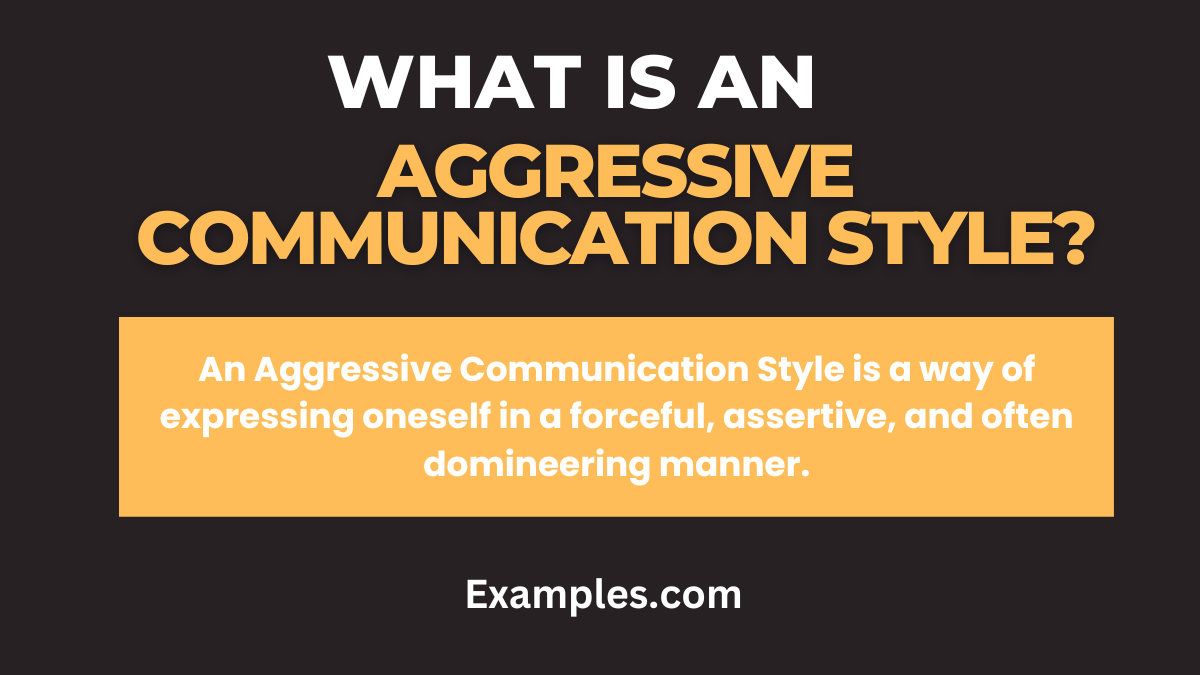9+ Aggressive Communication Style Examples
Dive into the realm of aggressive communication style with our comprehensive guide, enriched with real-world Aggressive Communication Examples. This style, known for its directness and assertiveness, plays a significant role in various interaction dynamics. Our guide offers a deep understanding of aggressive communication, its characteristics, and its impact in different contexts, from professional settings to personal relationships. With practical examples and tips, this guide is an essential resource for anyone looking to navigate or adapt this powerful communication style effectively.
What is an Aggressive Communication Style? – Definition

An Aggressive Communication Style is a way of expressing oneself in a forceful, assertive, and often domineering manner. This style is characterized by a tendency to speak in a loud and demanding tone, using direct and blunt language. Aggressive communicators often assert their opinions over others, may interrupt or talk over people, and can display hostile body language. This communication style, while assertive, often lacks the empathy and understanding found in more balanced forms of communication, such as assertive communication. It’s essential to recognize this style, particularly in contexts like aggressive communication in the workplace, to manage its impact effectively.
10 Aggressive Communication Styles

Understanding different aggressive communication styles is key to recognizing and addressing them effectively, especially in contexts like aggressive communication in the workplace or personal relationships. This section outlines 10 distinct styles, each with a unique set of characteristics and implications. From direct confrontation to verbal attacks, these styles highlight various aggressive communication methods. Recognizing these styles can aid in developing strategies for more empathetic and constructive communication, enhancing both professional communication examples and personal interactions.
- Direct Confrontation: Characterized by openly challenging or opposing others, often leading to conflicts and strained relationships.
- Intimidation Tactics: Involves using threats, either verbal or non-verbal, to instill fear and coerce others into compliance, creating a tense environment.
- Manipulation: Subtly influencing or controlling others for personal gain. This style can undermine trust and lead to deceptive communication dynamics.
- Verbal Attacks: Includes personal insults or criticisms, often causing emotional distress and damaging relationships.
- Impatience and Interruption: Demonstrated by frequent interruptions and showing impatience during conversations, which can hinder effective communication and collaboration.
- Sarcasm and Mockery: Using sarcasm to belittle or mock others, often leading to misunderstandings and hurt feelings.
- Blame and Accusation: Regularly blaming others without taking personal responsibility, which can erode team morale and trust.
- Overbearing Behavior: Dominating conversations and decision-making processes, often leading to a lack of diverse perspectives and ideas.
- Hostile Body Language: Using aggressive non-verbal cues like pointing fingers or invading personal space, which can escalate tensions.
- Dismissive Attitude: Displaying a lack of regard for others’ opinions or contributions, which can diminish team cohesion and individual self-esteem.
Aggressive Communication Style Tips
Effective management of an aggressive communication style is crucial for fostering productive and respectful interactions. This section provides 10 unique and practical tips, each explained comprehensively, to navigate and refine aggressive communication, particularly in aggressive communication in the workplace and personal relationships. From understanding its impact to balancing it with empathy, these tips offer valuable insights into transforming aggressive communication into a more constructive style, enhancing professional communication examples and interpersonal dynamics.
- Recognize the Impact: Acknowledge how aggressive communication affects others. Realizing its potential to cause discomfort or conflict is the first step towards modification.
- Practice Active Listening: Active listening can temper aggressive tendencies. By focusing on understanding others’ viewpoints, the need for domination in conversation can be reduced.
- Use “I” Statements: Replace accusatory “you” statements with “I” statements. This shift helps express your perspective without sounding confrontational or blaming in communication.
- Control Your Tone: Pay attention to your tone of voice. A calmer, softer tone can convey the same message without the harshness often associated with aggressive communication.
- Take a Pause: Before responding, especially in heated situations, take a moment to pause. This helps in controlling impulsive, aggressive reactions.
- Develop Empathy: Cultivating empathy can mitigate aggressive communication. Understanding others’ feelings and perspectives can lead to more respectful and effective exchanges.
- Set Clear Boundaries: While being assertive, it’s essential to set and respect boundaries. This ensures that assertiveness doesn’t cross into aggression.
- Seek Feedback: Regularly ask for feedback on your communication style. This can provide insights into how your approach is perceived by others.
- Engage in Self-Reflection: Regular self-reflection helps in recognizing patterns of aggressive communication and understanding underlying triggers.
- Seek Professional Development: Consider training or counseling focused on communication skills. This can provide strategies to modify an overly aggressive style, especially in aggressive communication in the workplace.
Aggressive Communication Style in the Workplace
An aggressive communication style in the workplace can significantly impact team dynamics, productivity, and the overall work environment. This detailed guide explores how such a communication style manifests in professional settings and its implications. Often characterized by direct confrontation, verbal attacks, and intimidation tactics, aggressive communication can lead to a hostile work atmosphere. However, in certain situations like crisis management or urgent decision-making, elements of this style can be effective.
This guide offers insights into identifying aggressive communication patterns, understanding their effects on team morale and collaboration, and strategies for mitigating negative impacts. Emphasizing the importance of balancing assertiveness with empathy, the guide aims to improve workplace interactions, fostering a more collaborative and respectful environment. Recognizing and appropriately managing an aggressive communication style is crucial for maintaining a healthy and productive workplace, especially in scenarios requiring aggressive communication methods and conflict resolution.
In summary, this guide on Aggressive Communication Style offers a comprehensive understanding of its various forms and impacts, especially in the workplace. While certain aspects can be effective in specific scenarios, the overall emphasis is on balancing assertiveness with empathy and respect. These insights and tips aim to enhance workplace communication, fostering a more productive and harmonious environment for all involved.



